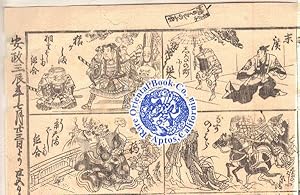Setomono (2 results)
Product Type
- All Product Types
- Books (2)
- Magazines & Periodicals
- Comics
- Sheet Music
- Art, Prints & Posters
- Photographs
- Maps
-
Manuscripts &
Paper Collectibles
Condition
- All Conditions
- New
- Used
Binding
- All Bindings
- Hardcover
- Softcover
Collectible Attributes
- First Edition
- Signed
- Dust Jacket
- Seller-Supplied Images (1)
- Not Printed On Demand
Seller Location
Seller Rating
-
Set Novelty Ceramics that send dreams to the world [Japanese Edition]
Seller: Librairie Chat, Beijing, China
Condition: Fine. Number of pages: 119p Size: 30cm Number of books: 1 book.
-
CHI.SETOMONO ISSHIKI TSUKURI MONO NO BANDZUKE: A RANKING OF JAPANESE CERAMICS
Seller: RARE ORIENTAL BOOK CO., ABAA, ILAB, Aptos, CA, U.S.A.
Osaka 1856. A large Kawaraban, sheet: 49 x 35.4, print: 45.4 x 32.3, black and white woodblock print, very clean paper, a few old mended holes, solid, excellent impression, with 12 boxed illustrations of prosperous Japanese. OBSCURE EXAMPLE . *** **** *** . . . A FASCINATING LARGE KAWARABAN [BROADSIDE] POSTER . . . ILLUSTRATING TWELVE BOXES OF JAPANESE CERAMIC FIGURES . . . MADE DURING THE ANSEI PERIOD [1854] . . . WOODBLOCK PRINTED . * The title is very hard to read, we can only partially read as: CHI.,SETOMONO ISSHIKI TSUKURI MONO NO BANDZUKE [RANKING LIST OF JAPANESE CERAMIC FIGURES MADE DURING THE ANSEI PERIOD]. . The meaning of the title is 'symbolic' which obscures the actual content by lack of a realistic descriptive title. . Nevertheless this Kawaraban illustrates examples of Japanese 'Setomono' [ceramics] from the period during 1854, the arrival of Commodore Perry to Japan. . Please review the photos posted to our website to get the flavor of the illustrations. . These illustrations are also related to Kabuki or Joruri theater performances. Little is clear about this example. . *** ANSEI PERIOD EVENTS: The history about Ansei 3rd year. It was a year of disaster in Tokyo area, with an earthquake and huge flood. It was also the year that American Admiral Perry visited Japan. In a way, the crashing down of Japan's hitherto isolation from the western world was a kind of "Mappo" or revenge of nature on Japan. . Nevertheless, this was also a period of great wealth for some Japanese as evidence is illustrated in this Kawaraban [broadside print.] . It illustrates ten squares with famous & well-known wealthy period. Each depicts some personal attributes with background texts of identification and a likeness drawing. There are men and women depicted. They are shown as elegant people, wearing elaborate silk Kimono in some cases. There are military men [Samurai warriors], mythological 'Gods,' archers, Tengu, young men reading a scroll, flute player who is being ambushed, a woman that brings forth "Koban" gold coins] from tree trunk, rat eating a scroll & being beat by the master, horse-back Samurai-archers and the like. . About "TENGU" Often called "Heavenly Dog" or "Heavenly Sentinel") are a type of legendary creature found in Japanese folk religion. They are considered a type of Yokai (supernatural beings) or Shinto Kami (gods). . Although they take their name from a dog-like Chinese demon (Tiangou), the Tengu were originally thought to take the forms of birds of prey, and they are traditionally depicted with both human and avian characteristics. The earliest Tengu were pictured with beaks, but this feature has often been humanized as an unnaturally long nose, which today is widely considered the tango s defining characteristic in the popular imagination. They are also thought to have been influenced by the Garuda. . Buddhism long held that the Tengu were disruptive demons and harbingers of war. . *** There is a publisher's colophon in the right margin, half is trimmed off, some Kanji hard to read; in the left margin, a date colophon, at the top margin is another seal. . *** UNUSUAL SUBJECT: This print represents a very unique and seldom found subject matter. The Japanese are loath to talk about wealth because of the superstitious saying "Bachi Attaru" ["hit with bad luck"]. Since this Kawaraban is not specifically boasting personal wealth, it is merely about other people's wealth or good fortune. . A final point, being printed and from Osaka, known for its highly 'mercantile' attitudes and philosophy of "making money" it s entirely fits in with Osaka pathos and preoccupations since Edo period [1604-1912]. . *** CONDITION: The work is printed on a single Deluxe & large Kawaraban, with mild center fold, neatly period re-backed, there is a bit of the usual surface dusty, otherwise clean. There are a few old and tiny mended worm holes, else a very solid and obscure example. Each box is about 10.35 x 8 cm., with excellent impression, black ink on white Washi paper. Suitable for framing and display. . *** Color scans are posted to our website. . *** REFERENCES: . Ansei Period: see wikipedia-org during the Ansei period. * TENGU: see wikipedia-org * KOBAN: ditto above regarding an old Japanese gold coin. . *.



